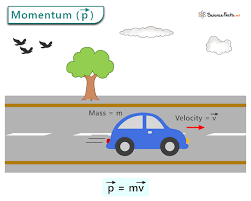Definition of Momentum
Momentum is one of the most fundamental and conserved quantities in all of physics. It captures an object's tendency to keep moving, and it forms the backbone of analyzing collisions, explosions, and recoil scenarios.
What is Linear Momentum?
Linear momentum \( \vec{p} \) is defined as the product of an object’s mass \( m \) and its velocity \( \vec{v} \). Linear momentum differs from inertia because intertia only depends on an object’s mass \( m \) not its velocity \( \vec{v} \). Since velocity is a vector, momentum is also a vector quantity, meaning it has both magnitude and direction.
- Mass is a scalar and must be constant (non-relativistic).
- Velocity determines the direction of momentum.
- Momentum points in the same direction as velocity.
Key Properties of Momentum
- Units: kg·m/s
- Momentum is always conserved in isolated systems with no net external force.
- Doubling the mass or the speed doubles the momentum.
Total Momentum in Systems
In a system of multiple particles (like in a collision), total momentum is the vector sum of the individual momenta. This total momentum remains constant if no net external forces act on the system.
Momentum and Newton's Second Law
Newton’s Second Law, in its most general form, tells us that net force is the time rate of change of momentum. This is valid even when mass changes (like in rocket propulsion). In most AP Physics C problems, mass is constant, so this reduces to:
This connection between force and momentum is what leads into the concept of impulse — the change in momentum due to a net force acting over time.
